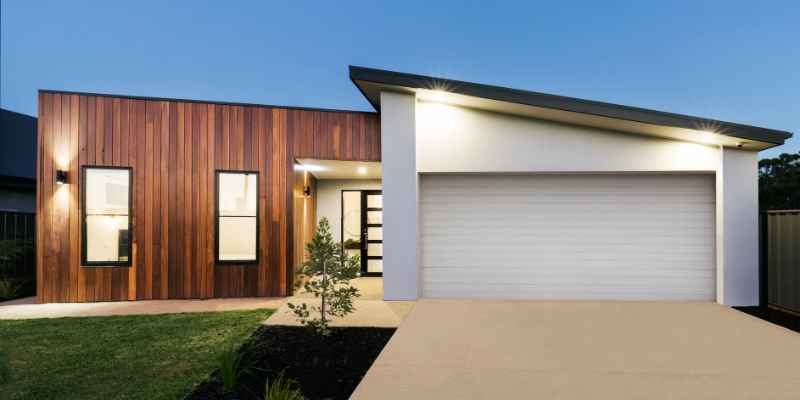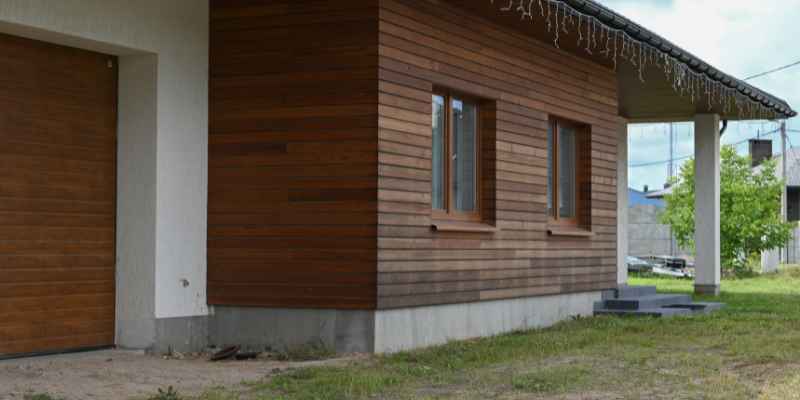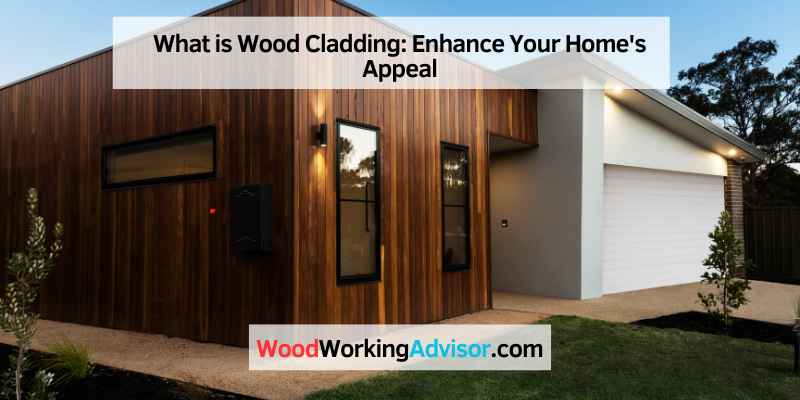Wood cladding is a type of exterior finish for buildings made by layering thin strips of wood together. It not only enhances the design of a home but also provides insulation against moisture and air penetration.
Wood cladding is typically used to provide a decorative and protective finish to the facade of a building. It is commonly made from various types of timber, such as softwood or hardwood, including species like western red cedar, European larch, and Douglas fir.
These types of wood are naturally resistant to insects, moisture, and rot, making them ideal for cladding without the need for preservative treatment.
Advantages Of Wood Cladding
Wood cladding is a popular choice for adding a natural and warm aesthetic to buildings. It not only enhances the visual appeal but also offers several advantages, making it a preferred choice for both residential and commercial structures.
Enhances Aesthetics
Wood cladding creates a visually appealing exterior for buildings, adding warmth and character. The natural textures and grains of wood provide a timeless and elegant look that can enhance the overall appearance of a structure. Whether it’s a modern or traditional design, wood cladding can add a touch of sophistication to any building.
Provides Insulation
One significant advantage of wood cladding is its ability to provide insulation to buildings. The insulating properties of wood help regulate internal temperatures, reducing the need for excessive heating or cooling. This not only promotes energy efficiency but also contributes to lower utility costs, making wood cladding a sustainable and cost-effective choice.
Environmentally Friendly
Wood cladding is an environmentally friendly option as it is sourced from renewable and sustainable forests. Using wood as a cladding material reduces the dependency on non-renewable resources, making it a more eco-friendly alternative. In addition, wood cladding has a lower carbon footprint compared to other building materials, further contributing to a greener environment.
Types Of Wood Cladding
Wood cladding is a popular choice for adding warmth, texture, and character to both interior and exterior spaces. There are various types of wood cladding available, each with its own unique features and advantages. In this section, we will explore different timber options and compare various wood species commonly used for cladding.
Timber Options
Timber cladding is made from different types of timber, including softwood and hardwood. Some of the most popular timber options for cladding include:
- European Redwood: Known for its durability and affordability, European redwood is a widely used timber option for cladding. It offers excellent resistance to decay and can be easily stained or painted.
- Western Red Cedar: Western red cedar is a highly sought-after timber for cladding due to its natural resistance to insects, moisture, and rot. It has a beautiful reddish-brown color and is often left untreated to showcase its natural characteristics.
- Siberian Larch: Siberian larch is a popular choice for cladding in the UK. It is known for its exceptional durability and distinctive grain patterns. Siberian larch cladding is highly resistant to decay and requires minimal maintenance.
- British Larch: British larch is another timber option commonly used for cladding. It offers similar attributes to Siberian larch, including durability and resistance to decay. British larch cladding develops a beautiful silver-gray patina over time.
Comparison Of Different Wood Species
When selecting wood cladding for your project, it’s important to consider the characteristics and attributes of different wood species. The table below provides a comparison of some popular wood species used for cladding:
| Wood Species | Durability | Natural Resistance | Maintenance Requirements |
|---|---|---|---|
| European Redwood | Medium | Low | Regular painting or staining |
| Western Red Cedar | High | High | Minimal maintenance required |
| Siberian Larch | High | High | Minimal maintenance required |
| British Larch | Medium | Medium | Regular maintenance to preserve color |
Each wood species offers its own unique advantages and considerations, so it’s important to choose the one that best suits your specific project requirements.
Installation And Maintenance
Wood cladding not only enhances the aesthetic appeal of a building but also provides protection against the outdoor elements. Proper installation and maintenance are crucial to ensure the longevity and durability of wood cladding.
Proper Installation Techniques
- Ensure the surface is clean and dry before installing the wood cladding.
- Use appropriate tools such as nails, screws, and adhesives for securing the cladding.
- Follow manufacturer’s guidelines for proper alignment and spacing of the cladding boards.
- Apply a weather-resistant barrier behind the cladding to prevent moisture infiltration.
- Regularly inspect the installation for any signs of damage or wear.
Maintenance Tips
- Clean the wood cladding regularly using a mild detergent and water solution.
- Inspect the cladding for signs of decay, rot, or pest infestation.
- Reapply protective finishes such as stains or sealants as needed to maintain the wood’s integrity.
- Trim overhanging branches to prevent damage from falling debris.
- Consider periodic inspections by a professional to address any potential issues.

Wood Cladding Vs. Other Alternatives
Wood cladding is a sustainable option that enhances aesthetics and provides insulation. It offers natural beauty and durability compared to other alternatives, making it a popular choice for eco-conscious projects. Wood cladding stands out for its versatility and ability to withstand external elements effectively.
Wood cladding is a popular choice for many homeowners due to its natural beauty, durability, and eco-friendliness. When comparing wood cladding to other alternatives such as siding, there are several key differences to consider.
Comparison With Siding
Siding is applied directly to a wall, while cladding is used to the exterior of an insulated wall assembly. This distinction is important as cladding creates a drainage plane and water-resistive barrier (WRB), providing additional protection against water damage.
Wood cladding offers a unique aesthetic appeal that siding may not achieve. With its warm, organic look, wood cladding can add a touch of natural beauty to any home or building. Siding, on the other hand, can come in a variety of materials such as vinyl, fiber cement, or aluminum, but may not have the same timeless charm as wood.
Additionally, wood cladding is a sustainable choice as it is made from natural timber, like softwood or hardwood. On the contrary, materials like vinyl or fiber cement used for siding are often manufactured synthetically and may not be as environmentally friendly.
Advantages Over Other Materials
There are many advantages to choosing wood cladding over other materials. Firstly, a building with timber cladding will be well-ventilated, allowing for proper air circulation and creating a comfortable living environment. This natural ventilation can contribute to more energy-efficient homes, reducing the need for excessive heating or cooling.
Furthermore, wood cladding offers excellent protection against outdoor elements such as wind and rain. It is naturally durable and can withstand harsh weather conditions, making it a reliable choice for long-term use. Other materials, like vinyl or fiber cement siding, may not have the same level of durability and may require regular maintenance or replacement.
In terms of aesthetics, wood cladding brings a warm and timeless appeal to any building. Its natural grains and textures create a unique and inviting atmosphere. Other materials, while functional, may lack the character and charm that wood cladding can provide.
In conclusion, wood cladding offers several advantages over other alternatives such as siding. Its eco-friendliness, durability, and timeless beauty make it a popular choice among homeowners. Whether you’re looking to enhance the appearance of your home or improve energy efficiency, wood cladding is a versatile and sustainable option to consider.
Applications Of Wood Cladding
Wood cladding is a versatile material that can be used in various applications, both for exterior design enhancement and interior design. Its natural appeal and durability make it a popular choice for architectural and design purposes. Let’s explore the diverse applications of wood cladding in different settings.
Exterior Design Enhancement
Wood cladding offers a wide range of benefits for exterior design, making it a popular choice for enhancing the visual appeal and functionality of buildings. Here are some key applications:
- Residential Homes: Wood cladding is often used to create a rustic and warm aesthetic for residential properties. It adds a natural charm to the facade, creating an inviting and timeless look.
- Commercial Buildings: Many commercial structures utilize wood cladding to evoke a sense of sophistication and modernity. The material can be employed in contemporary architectural designs to add character and uniqueness to the building’s exterior.
- Environmental Benefits: Wood cladding provides insulation and weather resistance, contributing to energy efficiency and environmental sustainability. It also offers natural ventilation and protection against the elements, making it an eco-friendly choice for exterior cladding.
Interior Design Applications
Wood cladding is not limited to external applications; it also holds significant value in interior design. Its versatility and aesthetic appeal make it suitable for various interior settings:
- Feature Walls: Wood cladding can be used to create visually striking feature walls in residential and commercial interiors. It adds warmth and texture, becoming a focal point in the space.
- Ceilings and Floors: Wood cladding on ceilings and floors exudes a sense of natural elegance, bringing warmth and character to interior spaces. It can create a seamless flow between indoor and outdoor environments.
- Acoustic Benefits: In addition to its aesthetic appeal, wood cladding can also contribute to sound insulation, enhancing the acoustic performance of interior spaces. This makes it a practical choice for spaces where noise control is essential.
Key Considerations When Choosing Wood Cladding

When it comes to choosing wood cladding for your property, there are several key considerations to keep in mind. The right wood cladding can not only enhance the aesthetic appeal of your home but also provide durability and protection against the elements. In this blog post, we will explore some essential factors that should be taken into account when selecting wood cladding.
Climate Suitability
Before choosing wood cladding, it’s crucial to consider the climate in which your property is located. Different wood species have varying levels of resistance to moisture, sunlight, and temperature fluctuations. Select a wood species that is well-suited to the specific climate of your region to ensure longevity and minimal maintenance.
Budget Considerations
Wood cladding comes in a wide range of options, each with its own cost implications. Consider your budget and explore the available wood cladding materials that align with your financial resources. While some wood species may be more expensive upfront, they may offer long-term cost savings due to their durability and low maintenance requirements.
Frequently Asked Questions On What Is Wood Cladding
Is Wood Cladding A Good Idea?
Wood cladding is a good idea as it promotes ventilation, energy efficiency, and protects buildings from outdoor elements like wind and rain. It is environmentally friendly and offers various species options for a natural, durable finish.
What Is The Difference Between Siding And Cladding?
Siding is applied directly to a wall, while cladding is used on the exterior of an insulated wall. Cladding can be set apart from the sheathing, creating a drainage plane and water-resistive barrier.
What Is Timber Cladding Made Of?
Timber cladding is made from different types of timber, like softwood or hardwood. Popular choices include European redwood, western red cedar, Siberian larch, and British larch.
What Kind Of Wood Is Used For Cladding?
Common woods used for cladding include Western red cedar, European larch, European oak, and Douglas fir. These species are naturally resistant to insects and rot, whereas other species like spruce, fir, and pine require treatment.
Conclusion
To conclude, wood cladding offers numerous advantages for buildings. It not only enhances a structure’s aesthetic appeal but also provides protection against the elements. Wood cladding promotes energy efficiency and ventilation, making it an environmentally friendly choice. Additionally, it is available in various timber options such as redwood, cedar, and larch, each with its own unique characteristics.
With its durability and natural resistance to insects, moisture, and rot, wood cladding is a popular choice for both commercial and residential buildings.


